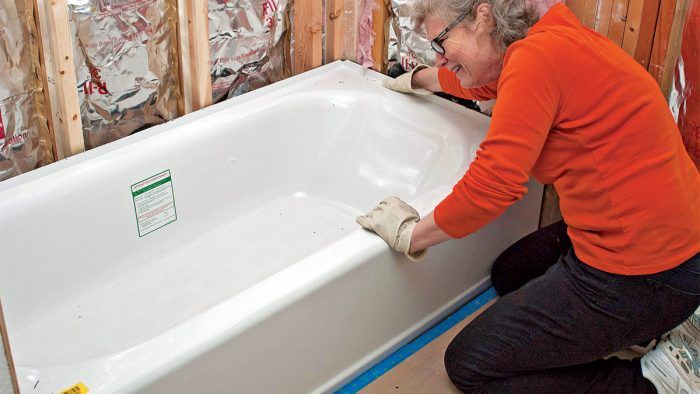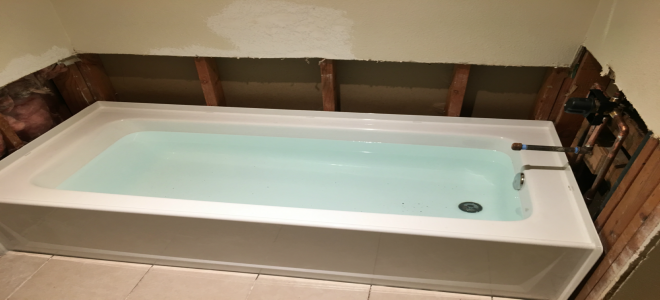Are you currently trying to locate info about A Step-by-Step Guide to Installing a Bathtub?

Setting up a bathtub isn't specifically brain surgery, yet it does need strong plumbing, carpentry, and often, tiling skills. Replacing an old tub with a brand-new one is additionally a moderately challenging task. If the old tub is easily available, the job can relocate easily; if you have to open a wall surface to get rid of the old tub and place the brand-new bathtub, the task is a lot harder. In either case, the task is within a residence handyman's skills, although you will require an assistant to move out the old tub as well as set in the new one. Ensure you have certified on your own for the job and also fit trying it. Rather than employing a service provider to take control of a halfway-completed task, it is much better to take into consideration employing one prior to you begin. Possibilities are you may need a specialist plumber to make tube connections.
This article will aid you install a brand-new bathtub in your shower room if you have currently acquired a brand-new tub and also don't require to transform the setup of your previous supply of water pipes.
Your tools as well as material checklist should consist of the following:
Getting ready for the Installation
To start with, the supporting framework supplied with the bath should be fitted (if needed) according to the supplier's directions. Next, fit the faucets or mixer to the tub. When fitting the faucet block, it is very important to make certain that if the faucet features a plastic washing machine, it is fitted in between the bathroom and also the faucets. On a plastic bathroom, it is likewise practical to fit a supporting plate under the taps unit to stop pressure on the bath tub.
Fit the versatile tap connectors to the bottom of the two faucets making use of 2 nuts and also olives (occasionally provided with the tub). Fit the plug-hole outlet by smearing mastic filler round the sink electrical outlet opening, and after that pass the outlet through the hole in the bathroom. Utilize the nut supplied by the manufacturer to fit the plug-hole. Check out the plug-hole electrical outlet for an inlet on the side for the overflow pipe.
Next off, fit the end of the flexible overflow pipe to the overflow electrical outlet. After that, screw the pipe to the overflow face which should be fitted inside the bath. Make certain you utilize all of the provided washing machines.
Link the catch to the bottom of the waste electrical outlet on the bath tub by winding the string of the waste electrical outlet with silicone mastic or PTFE tape, and screw on the trap to the outlet. Connect the bottom of the overflow tube in a comparable manner.The bath must now be ready to be fitted in its last placement.
Removing Old Taps
If you require to replace old faucets with brand-new ones as a part of your installment, then the first thing you must do is separate the supply of water. After doing so, switch on the taps to drain pipes any water staying in the system. The process of removing the existing taps can be fairly bothersome because of the restricted gain access to that is commonly the situation.
Use a basin wrench (crowsfoot spanner) or a tap device to undo the nut that links the supply pipelines to the taps. Have a cloth ready for the staying water that will come from the pipelines. As soon as the supply pipes have actually been eliminated, utilize the same device to loosen the nut that holds the taps onto the bath/basin. You will certainly need to stop the solitary taps from transforming throughout this procedure. When the faucets have been eliminated, the holes in the bath/basin will certainly have to be cleaned up of any old securing substance.
Prior to proceeding to fit the new taps, compare the pipeline connections on the old taps to the brand-new taps. If the old taps are longer than the brand-new taps, after that a shank adapter is required for the brand-new taps to fit.
Installing the Tub
Utilizing the two wood boards under its feet, place the bathtub in the required placement. The wood boards are handy in uniformly spreading the weight of the tub over the area of the boards as opposed to concentrating all the weight onto 4 tiny factors.
The following objective is to guarantee that the bathtub is leveled all round. This can be attained by inspecting the level and also changing the feet on the tub until the level checks out level.
To mount faucets, fit all-time low of the furthest versatile faucet port to the suitable supply pipe by making a compression sign up with; after that do the same for the various other tap.
Switch on the water system and inspect all joints and also new pipework for leakages and tighten them if needed. Fill the bathtub and also check the overflow outlet and also the regular outlet for leakages.
Finally, fix the bath paneling as explained in the maker's user's manual. Tiling and also sealing around the bath tub must wait until the bath tub has been made use of at the very least when as this will certainly settle it into its last position.
Fitting New Touches
If the tails of the new faucets are plastic, then you will need a plastic port to stop damage to the string. One end of the port fits on the plastic tail of the tap and the various other end offers a link to the current supply pipes.
If you need to fit a monobloc, then you will require decreasing couplers, which connects the 10mm pipeline of the monobloc to the typical 15mm supply pipeline.
Next, position the faucet in the installing hole in the bath/basin ensuring that the washers are in area in between the tap and also the sink. Protect the faucet in place with the supplier offered backnut. When the tap is firmly in place, the supply pipelines can be connected to the tails of the faucets. The faucets can either be attached by utilizing corrugated copper piping or with regular faucet adapters. The previous type ought to be linked to the faucet ends initially, tightening only by hand. The supply pipes can later be linked to the various other end. Tighten up both ends with a spanner after both ends have actually been linked.
Tiling Around the Tub
In the area where the bath fulfills the tile, it is necessary to secure the accompanies a silicone rubber caulking. This is necessary as the fitting can move enough to crack an inflexible seal, creating the water to pass through the wall in between the bathroom and also the tiling, bring about issues with dampness and also possible leakages to the ceiling below.
You can choose from a selection of coloured sealers to blend in your components and also fittings. They are marketed in tubes as well as cartridges, and are capable of sealing spaces up to a size of 3mm (1/8 inch). If you have a bigger gap to fill up, you can fill it with spins of drenched paper or soft rope. Bear in mind to always fill the tub with water prior to securing, to enable the activity experienced when the bathtub remains in use. The sealer can crack fairly early if you do not think about this activity prior to securing.
Alternatively, ceramic coving or quadrant floor tiles can be made use of to edge the bath or shower tray. Plastic strips of coving, which are easy to use and also cut to dimension, are also conveniently readily available on the marketplace. It is suggested to fit the ceramic tiles using waterproof or waterproof adhesive as well as cement.
Bathtub Installation
How Important Is A Bathtub To Your Home?
High-quality baths, showers, and other bathroom updates are necessary when considering a smart investment in your home. It’s a room that you go to every day and one that is constantly being used by guests.The bathroom is one of the top trafficked rooms in a home and also one of the most valuable in terms of home resale.
Install Piping Before Tub
You will be using your existing drain and waste vent system, but pipes required include the hot and cold water supply lines and a pipe leading to a shower head. A mixing valve and shower head are also needed. Air chambers may be required.
Position the Tub
Lower the tub into place so that the continuous flange fits against the wall studs and rests on 1’x4' or 2’x4' supports. Anchor the tub to the enclosure with nails or screws inserted through the flanges into the studs.
NOTE: Remember, bathtubs and shower stalls may require support framing. A bathtub filled with water is extremely heavy, so check building codes and framing support before installing the tub.
Assemble Drain Connections
Assemble the bathtub drain connections by connecting the tub overflow with the tub drain above the trap, not beyond it. The trap will have a compression fitting that screws over the arm of the overflow assembly.
Place a Pipe For the Shower Head
First, locate a brass female threaded winged fitting and attach it to a framing support via a screw or a nail. Then run a pipe up the wall for the shower head. Sweat or solder the other side of the brass fitting to the top of the pipe.
Attaching Hot and Cold Water Lines
Attach your water lines for both hot and cold by sweating these directly into the hot and cold ports of the mixing valve. The mixing valve will be how water enters the tub’s system, not by the pipes themselves.
Install the Spout
Extend a piece of 1/2 inch pipe, or whichever length is specified in the manufacturer’s instructions, for the tub spout. Sweat on a male threaded fitting at the end of the pipe or use a brass nipple of the proper length and a 1/2 inch cap.
NOTE: At this point you should have your rough-in plumbing work inspected before proceeding further.
Check For Leaks
Restore the water pressure and check the drain connection and the supply pipes for any sign of leaking.
estore the Bathroom Wall
Replace the wall with moisture-resistant drywall as a base for your wall covering. Seal the joints between the wall and your new tub with silicone caulk as protection against water seepage.
https://www.berkeys.com/2016/12/02/bathtub-installation-dallas/

Do you enjoy reading up on Installing A Bathtub? Try leaving feedback below. We'd be glad to find out your thoughts about this review. We hope to see you back again in the future. Sharing is nice. Helping others is fun. Thank you for your time spent reading it.
Estimate Free